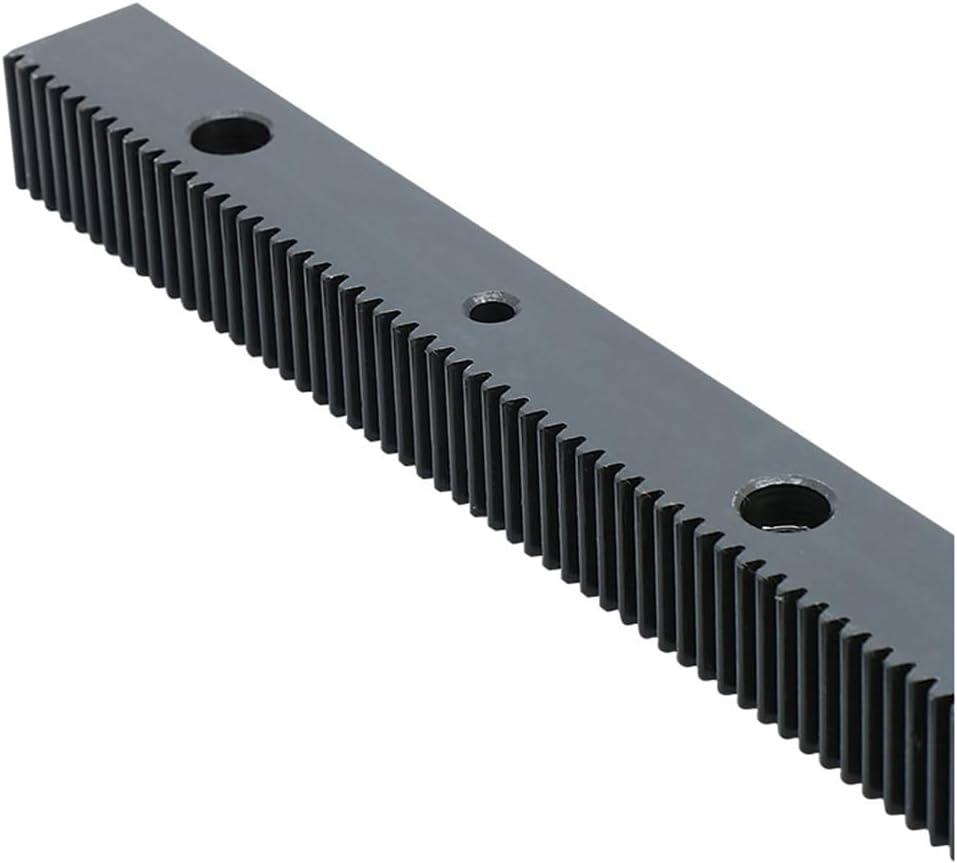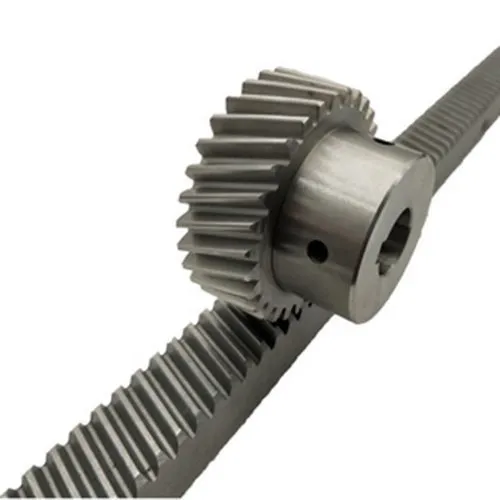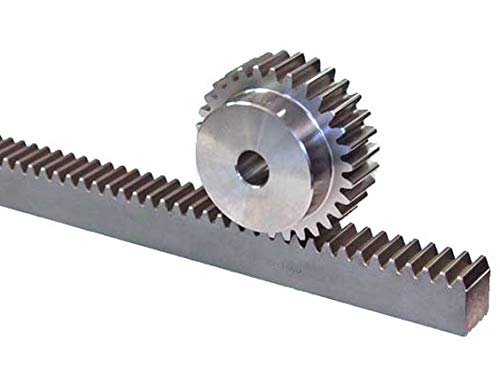Product Description
Flexible Nylon Stainless Steel Plastic Ground Helical Spur Metric window Gate Opener Pinion Gear Rack For Continuous Mounting
|
Product name |
Gear rack |
|||
|
Type |
Helical gear rack,spur gear rack,sliding gate gear rack |
|||
|
Module |
M1,M1.5,M2,M2.5,M3,M4,M5,M6,M8,M10 |
|||
|
Precision |
DIN6,DIN7,DIN8,DIN9 |
|||
|
Surface treatment |
Black oxide,zinc galvanize, heat treatment, |
|||
|
Material |
Carbon steel,stainless steel,brass,pom,nylon,plastic |
|||
|
Process method |
CNC machining, Turning, milling ,drilling, grinding,shaving,shaping,hobbing |
|||
|
Application |
Automotive Parts,Hareware Par,Construction,Machinery, |
|||
|
Standard |
ISO |
|||
Related products
/* January 22, 2571 19:08:37 */!function(){function s(e,r){var a,o={};try{e&&e.split(“,”).forEach(function(e,t){e&&(a=e.match(/(.*?):(.*)$/))&&1
| After-sales Service: | Installation Guide |
|---|---|
| Warranty: | 1.5 Years |
| Type: | Gear Rack |
| Application: | Excavator |
| Certification: | CE, ISO9001: 2000 |
| Condition: | New |
| Samples: |
US$ 9999/Piece
1 Piece(Min.Order) | |
|---|

Can metric gear racks withstand variations in environmental conditions?
Metric gear racks are designed to withstand variations in environmental conditions to a certain extent. Here’s a detailed explanation of the factors that affect the ability of metric gear racks to withstand environmental conditions:
1. Material Selection: The choice of material for the gear rack is an important consideration when it comes to environmental resistance. Different materials offer varying levels of corrosion resistance, temperature tolerance, and resistance to chemicals or other environmental factors. For example, stainless steel is known for its excellent corrosion resistance, making it suitable for applications exposed to moisture or harsh chemicals. Similarly, certain plastics or composite materials may offer better resistance to specific environmental conditions compared to metals.
2. Coatings and Surface Treatments: Applying specialized coatings or surface treatments can enhance the environmental resistance of gear racks. These coatings can provide protection against corrosion, wear, or chemical attack. Common coatings include zinc plating, nickel plating, or various types of paints or polymer coatings. Surface treatments such as nitriding or carburizing can improve the hardness and wear resistance of the gear rack, making it more resilient to environmental factors.
3. Sealing and Enclosure: In certain applications, gear racks may be enclosed or sealed to protect them from environmental conditions. This can involve using protective covers, seals, or gaskets to prevent the ingress of moisture, dust, or other contaminants. Sealing and enclosure methods help to maintain the integrity of the gear rack and minimize the impact of environmental variations.
4. Temperature Variation: Metric gear racks are designed to operate within specified temperature ranges. The material selection and thermal treatment of the gear rack components play a crucial role in determining their ability to withstand temperature variations. For example, steel alloys are known for their good thermal conductivity and can handle a wide range of temperatures. However, extreme temperature variations, especially rapid changes, can still affect the dimensional stability and performance of gear racks, necessitating appropriate design considerations.
5. Humidity and Moisture: Gear racks exposed to high humidity or moisture levels can be susceptible to corrosion and accelerated wear. The material selection, coatings, and sealing methods are crucial in protecting the gear rack from moisture-related issues. Stainless steel or corrosion-resistant coatings can help mitigate the effects of moisture, but regular maintenance and proper lubrication are also important to ensure the gear rack’s longevity in such conditions.
6. Chemical Exposure: In certain applications, gear racks may come into contact with chemicals or corrosive substances. The resistance of the gear rack to specific chemicals depends on the material composition and surface treatment. It is essential to select materials that are compatible with the chemicals present in the environment and to consider appropriate coatings or protective measures to prevent chemical attack or degradation.
7. Outdoor and Harsh Environments: Gear racks used in outdoor or harsh environments, such as construction equipment or agricultural machinery, may be exposed to additional challenges. These can include exposure to UV radiation, extreme temperatures, abrasive particles, or heavy vibrations. In such cases, materials with good weather resistance, impact resistance, and wear resistance are preferred. Additionally, effective sealing, periodic maintenance, and suitable lubrication are essential to ensure the gear rack’s performance and longevity.
While metric gear racks are designed to withstand variations in environmental conditions, it is important to note that their performance and longevity can be influenced by the severity and duration of exposure to these conditions. Regular inspection, maintenance, and adherence to manufacturer guidelines are crucial to ensure the gear rack’s optimal performance and reliability in specific environmental conditions.
In summary, the ability of metric gear racks to withstand variations in environmental conditions depends on factors such as material selection, coatings and surface treatments, sealing and enclosure methods, temperature variation, humidity and moisture resistance, chemical exposure, and the specific application requirements. By considering these factors and implementing appropriate design measures, engineers can enhance the gear rack’s resistance to environmental variations and ensure its reliable operation over the intended service life.

How do metric gear racks handle variations in backlash and precision?
Metric gear racks are designed to minimize variations in backlash and maintain high precision in motion control applications. Here’s a detailed explanation of how metric gear racks handle variations in backlash and precision:
1. Backlash Compensation: Backlash refers to the slight clearance between the teeth of the gear rack and the mating gear. It can introduce positional errors and reduce precision in motion control systems. Metric gear racks can handle variations in backlash by employing various techniques for backlash compensation. One common method is to use a pre-loaded system, where the gear rack and mating gear are designed to exert a slight pressure against each other. This pre-loading minimizes the clearance and reduces the effects of backlash, resulting in improved precision and repeatability in motion control. Additionally, backlash can be further reduced by utilizing gear racks with high tooth engagement ratios, precision manufacturing processes, and tight tolerances, ensuring minimal play between the gear rack and mating gear.
2. Precision Manufacturing: Metric gear racks are manufactured with precision to achieve high levels of accuracy and reduce variations in backlash. The tooth profile of the gear rack is carefully designed and manufactured to ensure smooth and consistent meshing with the mating gear. Advanced machining techniques, such as CNC (Computer Numerical Control) machining and grinding, are used to achieve precise tooth dimensions, tooth profiles, and pitch accuracy. This precision manufacturing process helps minimize variations in backlash and ensures a tight and consistent fit between the gear rack and mating gear, resulting in enhanced precision in motion control applications.
3. Tight Tolerances: Metric gear racks are produced with tight dimensional tolerances to maintain high precision. The manufacturing process ensures that the gear rack’s tooth spacing, pitch, and overall dimensions are within specified tolerances. These tight tolerances minimize variations in backlash and tooth engagement, leading to improved precision and accuracy in motion control. By adhering to strict tolerances, gear racks can reliably transmit motion without excessive play or variations, contributing to precise positioning and consistent motion control performance.
4. Quality Materials: The choice of high-quality materials for metric gear racks is crucial in maintaining precision and reducing backlash variations. Gear racks are commonly made from materials such as steel or stainless steel, which offer excellent strength, durability, and dimensional stability. These materials exhibit minimal expansion or contraction due to temperature changes, ensuring consistent tooth engagement and reducing the effects of thermal variations on backlash and precision. Additionally, the use of high-quality materials helps minimize wear and deformation, preserving the gear rack’s precision over its service life.
5. Regular Maintenance and Inspection: To ensure that metric gear racks continue to handle variations in backlash and maintain precision, regular maintenance and inspection are essential. Periodic lubrication of the gear rack and mating gear reduces friction and wear, optimizing the gear meshing and minimizing backlash variations. Regular inspections allow for the detection of any wear, damage, or misalignment that may affect precision. By addressing maintenance needs promptly and making necessary adjustments or replacements, the gear rack’s performance can be maintained at a high level of precision over time.
6. Application-Specific Optimization: Metric gear racks can be optimized for specific applications to further enhance precision and reduce variations in backlash. Factors such as tooth profile design, material selection, surface treatments, and gear geometry can be tailored to minimize backlash and improve overall precision. By considering the specific requirements and constraints of the application, engineers can optimize gear rack design and configuration to achieve the highest possible precision and reduce variations in backlash.
In summary, metric gear racks handle variations in backlash and maintain high precision through various mechanisms. Backlash compensation techniques, precision manufacturing processes, tight tolerances, quality materials, regular maintenance, and application-specific optimization all contribute to minimizing backlash variations and ensuring high precision in motion control applications. By employing these measures, metric gear racks can reliably provide accurate and repeatable motion, enabling precise positioning and consistent performance in a wide range of applications.

How do metric gear racks handle variations in load capacity and speed?
Metric gear racks are designed to handle variations in load capacity and speed effectively. Here’s a detailed explanation of how they address these variations:
Metric gear racks accommodate variations in load capacity and speed through the following mechanisms:
1. Selection of Gear Rack Material: The choice of material for the gear rack plays a crucial role in determining its load capacity and speed handling capabilities. Gear racks are typically made from high-strength materials like steel or other durable alloys. These materials offer excellent load-bearing capacity and can withstand high forces without deformation or failure. The selection of the appropriate material ensures that the gear rack can handle varying loads without compromising its structural integrity or performance.
2. Proper Gear Rack Sizing: The size and dimensions of the gear rack are selected based on the anticipated load and speed requirements of the application. Larger gear racks with more substantial cross-sectional dimensions and larger teeth are capable of handling higher loads. Smaller gear racks are suitable for lighter loads. Proper sizing ensures that the gear rack can withstand the expected load capacity while maintaining the required speed and accuracy. Engineering calculations and analysis are often performed to determine the optimal size and dimensions of the gear rack for a given application.
3. Load Distribution: Gear racks distribute the applied load along their length, which helps in handling variations in load capacity. The toothed engagement between the gear rack and mating gears or pinions ensures that the load is evenly distributed across the entire length of the rack. This load distribution mechanism prevents localized stress concentration and minimizes the risk of failure or deformation in specific areas. By distributing the load, gear racks can handle variations in load capacity and maintain consistent performance throughout their length.
4. Lubrication and Maintenance: Proper lubrication and maintenance of gear racks are essential for ensuring their optimal performance under varying load and speed conditions. Lubrication helps reduce friction and wear between the gear rack teeth and the mating gears or pinions. Adequate lubrication minimizes heat generation, reduces the risk of premature wear, and maintains the overall efficiency of the gear system. Regular inspection and maintenance of gear racks, including cleaning, lubrication, and replacement of worn components, help extend their service life and ensure reliable operation under varying load and speed requirements.
5. System Design and Integration: The overall design and integration of the gear rack system play a vital role in handling variations in load capacity and speed. Proper system design includes selecting compatible gears or pinions, ensuring proper alignment, and considering factors such as torque requirements, backlash, and speed ratios. By designing the gear rack system appropriately, engineers can optimize its performance and ensure that it can handle variations in load capacity and speed effectively.
It is important to note that while gear racks can handle variations in load capacity and speed, there are limits to their capabilities. Exceeding the recommended load capacity or operating at excessively high speeds can lead to premature wear, increased backlash, reduced accuracy, and potential system failure. Therefore, it is crucial to carefully consider the specific load and speed requirements of the application and select gear racks that are suitable for the anticipated operating conditions.
In summary, metric gear racks handle variations in load capacity and speed through the selection of appropriate materials, proper sizing, load distribution, lubrication and maintenance, and thoughtful system design and integration. By considering these factors, gear racks can effectively handle varying load and speed requirements while maintaining accurate and reliable linear motion.


editor by CX 2024-03-27